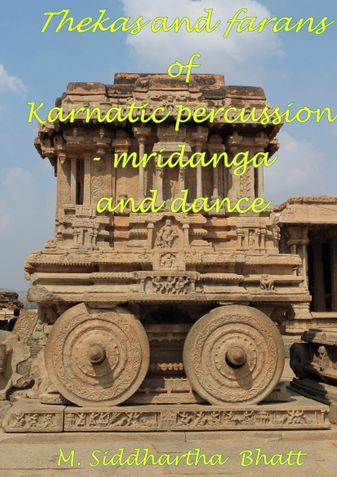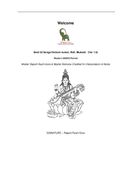You can access the distribution details by navigating to My pre-printed books > Distribution
Description
The focus of this book (983 pages) is on the development of the two primary rhythm structures (thekas and farans) from the raw sounds to musical syllables and thenceforth onto basic strings, compound strings, sequences, avartanas and finally verses.
The first introductory chapter describes some aspects special to mridanga art and the percussion fraternity.
The second chapter deals with elementary unmetered stand-alone raw sounds which are structured into mridanga strokes and syllables for deploying them to generate sequences to fit talas.
The third chapter covers the subject of talas (musical meter) which provide an operational framework for showcasing the thekas and farans. The popular talas and the facets of tala such as syllables (aksharas), beats (mathras), cycle (avartana), string size (akshara jati), beat size (nadai), operational tempo (kala), points of resolution (sama and visama) are brought out.
The basic building block rhythm structures are the sub-strings and the strings which are a series of strokes of raw sound clubbed or coupled into units. The compound strings generated from the base strings are presented in two chapters-the fourth chapter is assigned to theka strings and fifth chapter brings out the faran strings. The cycles of sequences of strings, fitted to avartanas (metering cycles) are then integrated into verses applicable to musical accompaniment during a song, during a tani avartana or applied to a dance.
The theka verses and faran verses are separately exhibited for the popular present day talas. The chapters on theka verses (76 in all with variations) are covered over four chapters into:
• Adi tala and Rupaka tala in chaturashra nadai
• Chapu talas- Kanda, Mishra and Sankeerna chapu talas in chaturashra nadai
• Adi tala in trishra, kanda, mishra and sankeerna nadais.
• Rupaka tala and the chapu talas Kanda, Mishra and Sankeerna chapu talas in the non-chaturashra nadais.
Faran verses (39 in all with variations) which form the other pillar on which the mridanga structures rest are presented over four chapters as under:
• Farans for mridanga practice, konnakol (oral rendition) and tani avartana for Adi tala and Rupaka talas in chaturashra nadai.
• Farans for tani avartana for chapu talas-Kanda, Mishra and Sankeerna chapu talas in chaturashra nadai.
• Farans for tani avartana for Adi tala and Rupaka tala in trishra, kanda, mishra and sankeerna nadais
• Farans for tani avartana for chapu talas- Kanda, Mishra and Sankeerna chapu talas in trishra, kanda, mishra and sankeerna nadais.
The above talas in various nadais cover virtually the majority of the subject matter of mridanga. A chapter is allocated for aspects of accompaniment of mridanga for primary music, dance and solo (tani avartana).
A chapter (15) is devoted to a glossary of vernacular (desheeya bhaashe) terms and pronunciations in Devanagari. The book contains over 230 Tables, 50 Figures, 20 Equations and 20 references.
About the Authors
Book Details
Ratings & Reviews
Re: Thekas and Farans of Karnatic Percussion (eBook)
There are very few books on the art of Mridangam and many of them are either in local language or heavily coded making it difficult for learners to pick up. In sharp contrast, this book is excellent both for the learners as well as for the practioners who can use it both as learning material as well as a knowledge refresher. The most interesting thing is that the different items such as pauses, blanks, etc. have been identified and the structure is built up using these. I found the book quite useful and I have great pleasure in recommending it to learners and mridangists. Besides, the sheer coverage of all the important thekas and farans is excellent.
Other Books in Music, Performing Arts
Prof Surjit Singh
Rajesh Rushi Eera
Sheo Khetan, Professor Surjit Singh
Dr Rajeswari Chellaiah





Re: Thekas and Farans of Karnatic Percussion (eBook)
The intent and objective of this book( authored by M. Siddartha Bhatt ) which is to systematize the primary rhythm structures of Karnatic percussion, viz., thekas and farans has been met in all respects. The author has successfully illustrated from the basics, i.e raw sounds and elementary strokes of Mrudanga, Mnemonics, Musical Metering as well as the building blocks of percussion structures. He goes on to extol the various combinations of the thekas and the relationships between their reference and operational tempos. The subtleties of the rendering, the finesse required and aspects related to the accompaniment of dance are very well brought out. Tani avartana, the percussion solo wherein all the tala vadyas will communicate and interact with each other, has been discussed in detail. The book is a delight to read.
I strongly recommend it for percussionists, mridanga learners, dance artists and in general to all lovers of carnatic music.
Dr G N Dayananda, Aerospace Scientist & Science Fiction writer